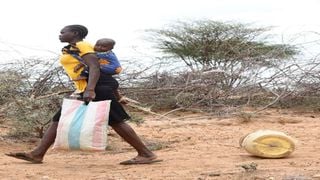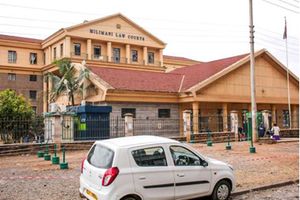
With a child strapped on her back, a woman heads home carrying her luggage while pulling a container of water on an improvised pulley in Kang’iregai village, Turkana South on September 21, 2021.
| Jared Nyataya | Nation Media GroupTurkana
Premium
Turkana water aquifer: The miracle that never was
When news of the discovery of a huge water aquifer in the arid Turkana county reverberated across the country in September 2013, the people were euphoric.
Locals grappling with perennial devastating droughts saw the aquifer as their sole hope since the water would be enough for their domestic and agricultural needs.
Hydrologists projected the water could be supplied to the whole country for 70 years.

Cecilia Amekwi, a resident of Napuu village who lives barely two kilometres from the aquifer, narrates how the village celebrated the water discovery in elaborate ceremonies to appease the gods for blessing them with water.
“Since my birth six decades ago, I have never witnessed such a phenomenon. We usually rely on flash waters and wells dug on river beds to get water for domestic use and for animals. With the aquifer, we were sure of establishing crop farming and ending the water scarcity,” she says.

To get any food, she said, they would walk the 20 kilometres to Lodwar town to buy it, or wait for food rations from the government and donors.
“I had never practised crop farming before, and the practice being introduced to me as an adult was strange. All along I have been relying on pastoralism during the rainy season and relief food whenever drought worsens and wipes out all the livestock," Amekwi tells the Nation.
But this changed when the national government, together with the county government, exploited the aquifer and sank at least five boreholes.
The completed Napuu water project ensures with more than 16,000 residents of Kanamkemer, Narewa, Lokitela, Ekaales, Mathewan, Kasarani, Juluk and Trans Africa as well as Turkana University College and Kanamkemer Sub-County Hospital, among others, accessing clean piped water from the aquifer.

The aquifer had been designed to provide water for both domestic and agricultural use. A total of 65 acres of land was put under irrigation with 418 households directly benefiting.
The county government allocated Sh72 million to establish a maiden drip irrigation scheme as one of the ways for locals to utilise the water from the aquifer after various tests recommended it was safe.
There are two giant water aquifers under the desert of Turkana county; Lotikipi and Napuu, which were discovered in 2013.
The Lotikipi aquifer is estimated to hold 200 billion cubic metres of water, enough to satisfy the needs of Kenya’s population for 70 years.
The discovery of drinkable water would have been life-changing since about 80 percent of people living in Turkana, Kenya’s largest county the size of Rwanda, Djibouti, and Burundi, combined, do not have access to 50 litres of water a day – the amount guaranteeing “that most basic needs are met”, according to the United Nations report then.

But a government report from 2015 showed that the water from the aquifer was too saline for human consumption, with mineral levels seven times the accepted limit. This was based on data from one of three wells and efforts to desalinate it through reverse osmosis are under way.
But the Napuu Aquifer that serves Lodwar town and its environs has fresh water, but is smaller than Lotikipi.
The mapping reported the aquifer has roughly a storage capacity of 10 billion cubic metres underlying Napuu village near Lodwar town.
At Napuu, Amekwi was trained together with fellow villagers on how to use jembes and grow various crops that included watermelon, collards, green grams, cowpeas, spinach, tomatoes, onions and an assortment of indigenous vegetables. They were even trained on how to prepare meals.

The Lodwar Town Fresh Produce Market primarily relied on fresh produce from Kitale and Kapenguria, but due to insecurity and poor road network that translated into high cost of maintaining vehicles, and the long hours taken for moving farm produce, consumers were forced to pay highly for poor quality vegetables.
“We embraced crop farming and we produced crops for subsistence, and the surplus was sold to Lodwar, earning us good money. These bountiful harvests ended in the fourth season,” she recalls.
According to Joseph Egiron, another farmer, production started to dwindle due to lack of water on some portions with some upper sections of the scheme not being served with water due to low pressure.
“We even approached the county government to boost the water supply system by rehabilitating the systems, which also had blocked drip pipes. Factions had already emerged with the management committee and also the community,” he says.
He says the hunger pangs they had mitigated and poverty are now back, after a brief period of enjoying crops from the scheme. He is calling on the county government to act fast and ensure the scheme’s revival.
“We are worried as a community because the project was meant to benefit us. We welcomed the project knowing that it would end our water problems, but it has stalled,” he says.
Soon, pipes and tanks were vandalised and some members destroyed the fence, allowing animals to graze in the farms, wiping out all crops, with the multi-million project collapsing.
"There was also an element of political interference pitting incumbents and aspirants. This cuts across all key projects in the county," he claims.
This led to poor supply of vegetables from the farm to the Lodwar market, leading to vegetable vendors, led by Norah Lobali, to appeal to the county government to fully support efforts by farmers engaging in crop production to ensure sustainable farming.
“Having a reliable source of fresh vegetables within Turkana County was more profitable for us as we never spend much of our capital on transport. Our customers too were assured of fresh vegetables and fruits," Lobali says.
The scheme now lies in ruins, littered all over as camels, sheep and goats have turned the once vibrant project into a grazing field.
The evergreen Prosopis juliflora weed, locally known as Mathenge, dots the expansive scheme as evidence of a very fertile land that is yearning for revival.
The current state of the scheme is the exact contrast of what Turkana Governor Josphat Nanok’s administration said it would be.
The county set up five boreholes to be powered by solar energy to irrigate the farms so that the county's dream of producing its own ‘fresh’ food would be realised.
Agriculture Executive Philip Aemun blames leadership wrangles within the committee for the collapse of the project that propelled the department to fame, with many locals, especially within Lodwar town, associating with it fresh vegetables.
"The community gave out land and with funds allocated, we successfully set up a drip irrigation scheme and handed it over to the community after we trained the top leadership. An agricultural extension officer was even attached to the project to offer technical support to the farmers on crop farming,” says the county executive.
He says trouble started when factions emerged and some claimed the scheme was set up on their ancestral land and the project should be entirely left to them.
“One group vandalised the project and destroyed it by cutting away the fence, destroying pipes and tanks and even allowed the goats to feed on the crops to completely chase away the farmers,” Aemun says.
There are several attempts being made to support the project, with partners ready to finance its revival if the groups will resolve their differences.
“We are working with furrows in the desert organisation to train beneficiaries on proper governance and also advise them on how to review their constitution for the success of the project," the county official says.
The county has 51 irrigation schemes across the county, which has seen the acreage under crops rise significantly from 9,000 acres to about 50,000.
“As a county our main focus was to make the county food secure and thus improve the nutrition of the locals. But some of the schemes collapse once they are handed over to the community because of the leadership wrangles which we are now attempting to address,” he says






